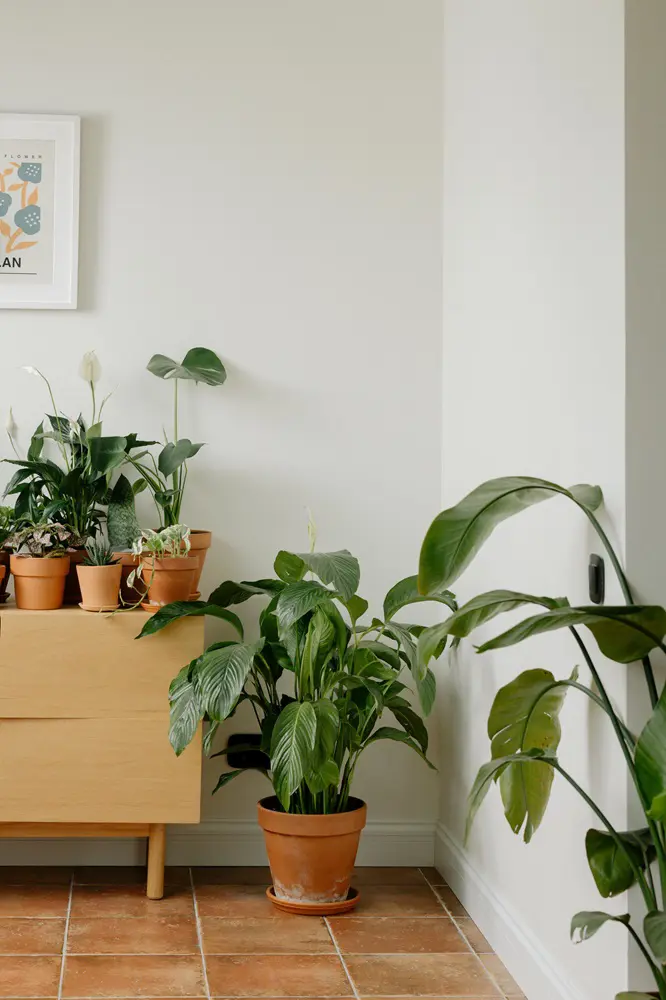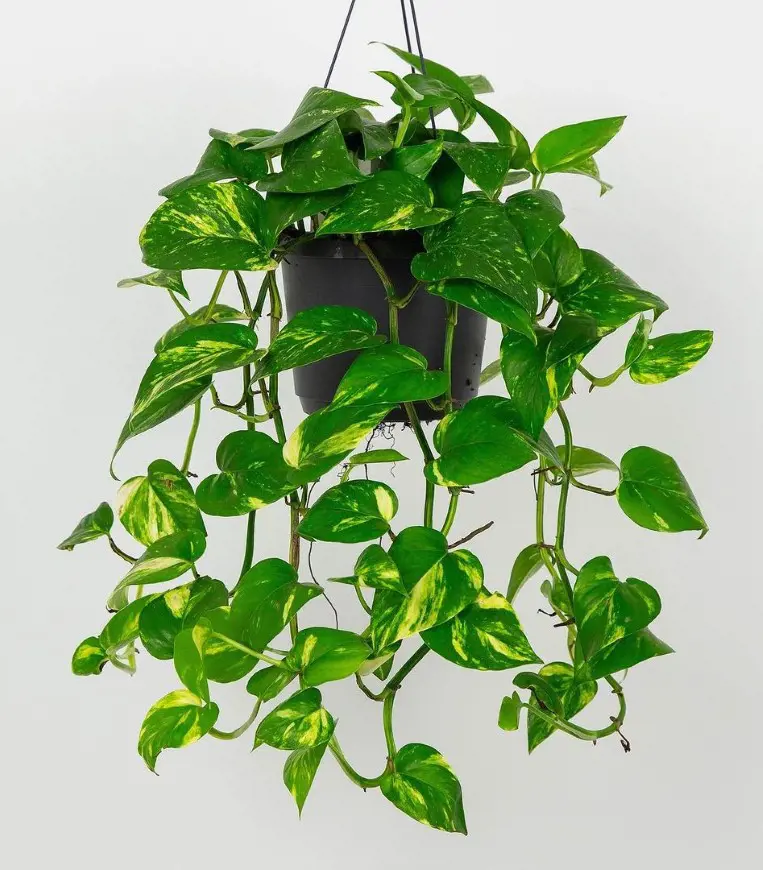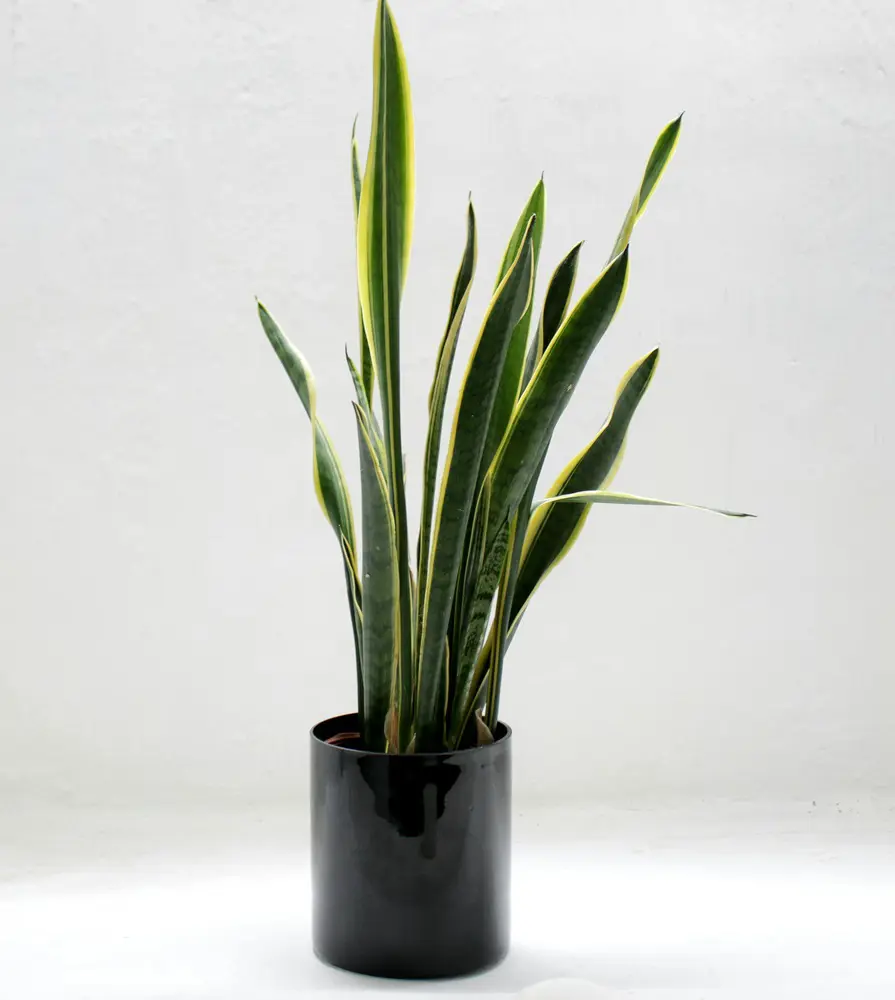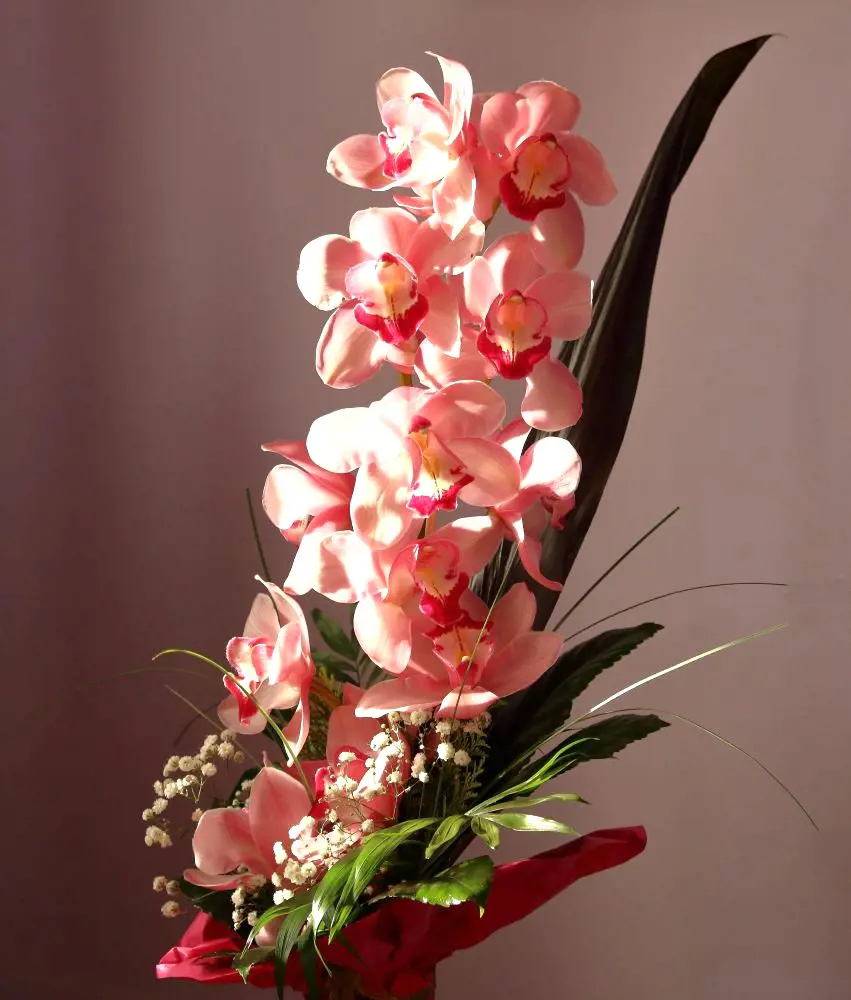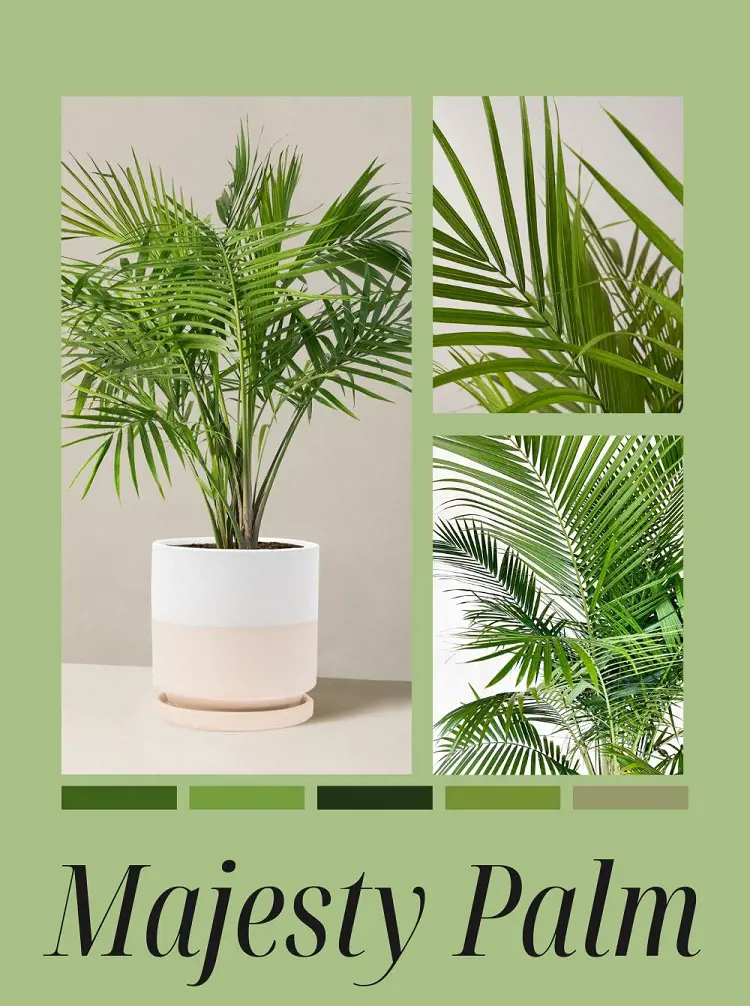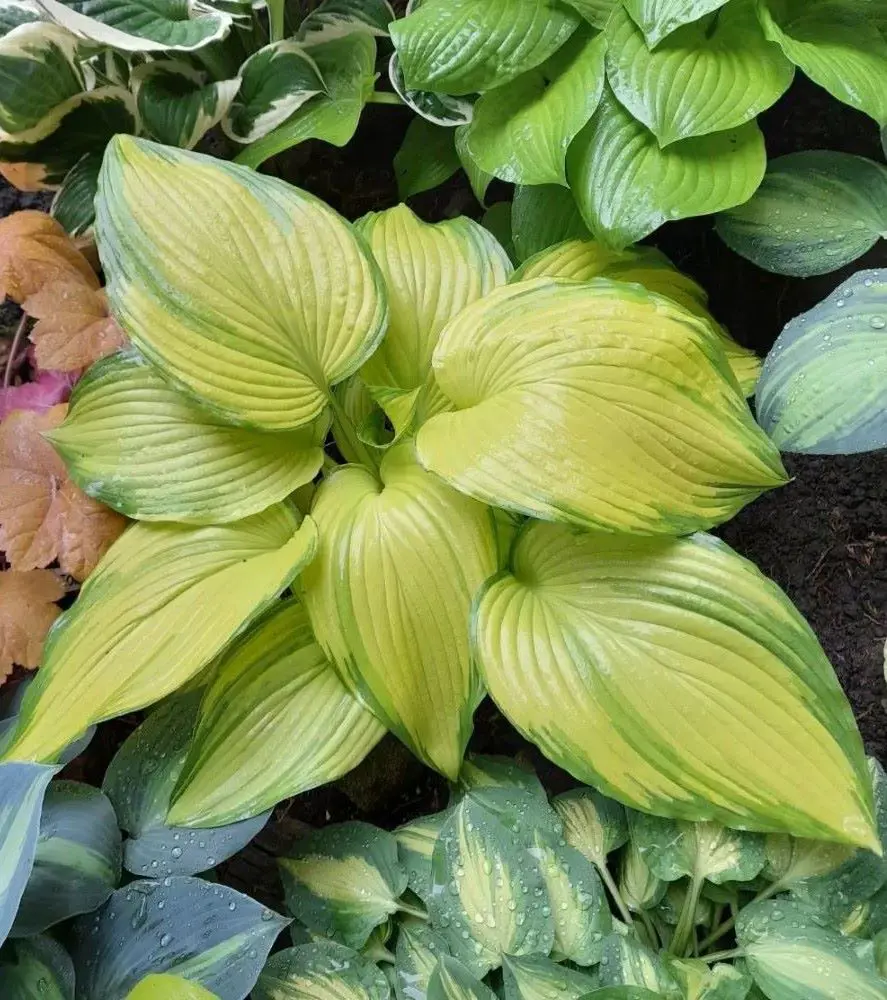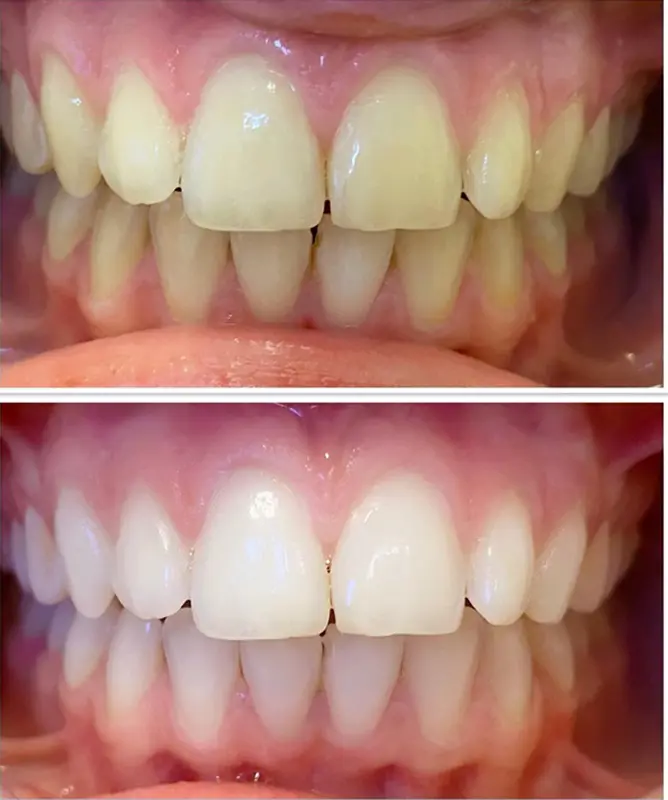How To Care Ponytail Palm In Indoor Environment
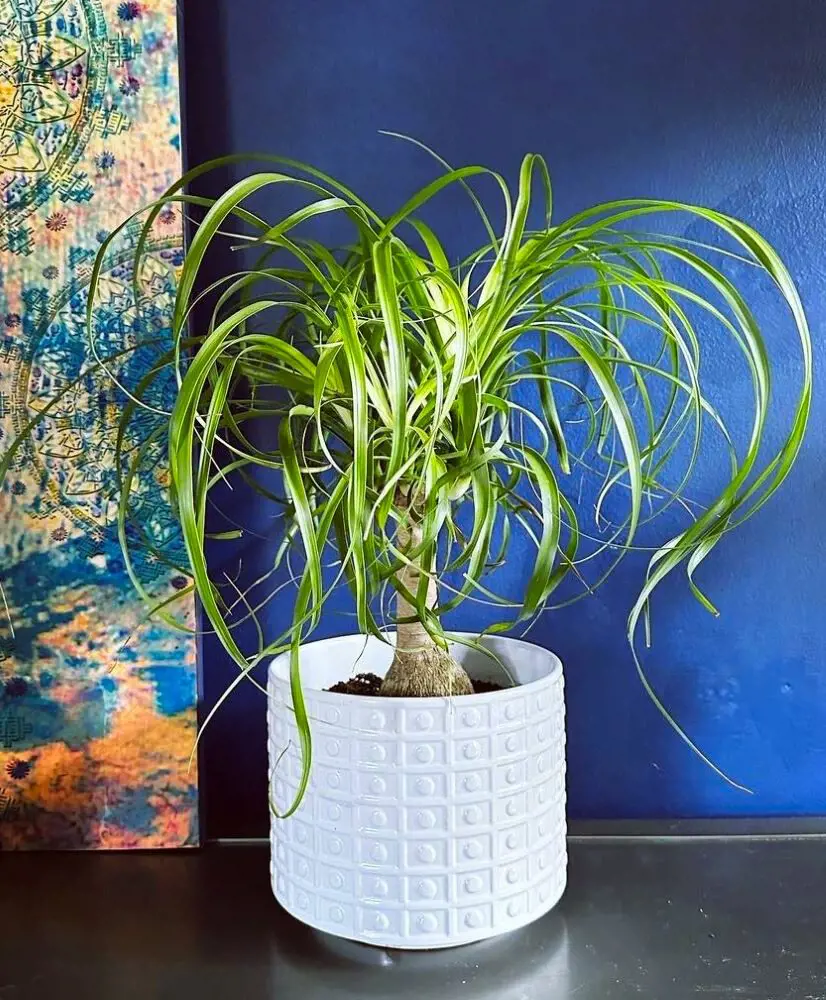
This post may contain affiliate links. If you make a purchase through links on our site, we may earn a commission.
Ponytail Palm, despite its name, is not a palm tree. It is a member of the Agave family and is more closely related to succulents.
This plant is an excellent choice for indoor cultivation because of its low maintenance requirements and unique appearance. In some cultures, Ponytail Palms are believed to bring good luck and prosperity - making them popular as decorative plants in homes and offices.
Ponytail Palm Overview
| Common Name | Ponytail Palm, Elephant's Foot |
| Scientific Name | Beaucarnea Recurvata |
| Type of Plant | Broadleaf Evergreen Shrub/Tree |
| Bloom Time | Seasonal Bloomer |
| Flower Color | Creamy White |
| Mature Size | 6-8 Ft. Tall (Indoors), Up to 30 Ft. Tall (Outdoors) |
| Hardiness Zones | 10 to 11 (USDA) |
| Native To | Central America Semi-desert Areas |
| Sun Exposure | Full Sun |
| Soil Type | Sandy, Well-draining |
| Soil pH | 6.5 to 7.5 (neutral) |
What is Ponytail Palm?

The Ponytail Palm is a unique and distinctive plant that is often grown as a houseplant. They have a distinctive appearance, characterized by a swollen, bulbous trunk that stores water.
The trunk tapers upwards and is topped by a cluster of long, slender, arching leaves that resemble a ponytail or a palm frond, hence the name. The leaves are typically dark green and can grow up to several feet long.
The flora is native to the arid regions of Mexico and is well adapted to warm, dry conditions. In their native habitat, Ponytail Palms can grow up to 30 feet tall, but when grown as indoor plants, they typically reach heights of 3 to 6 feet. They can also be grown outdoors in suitable climates.
Ponytail Palm Care
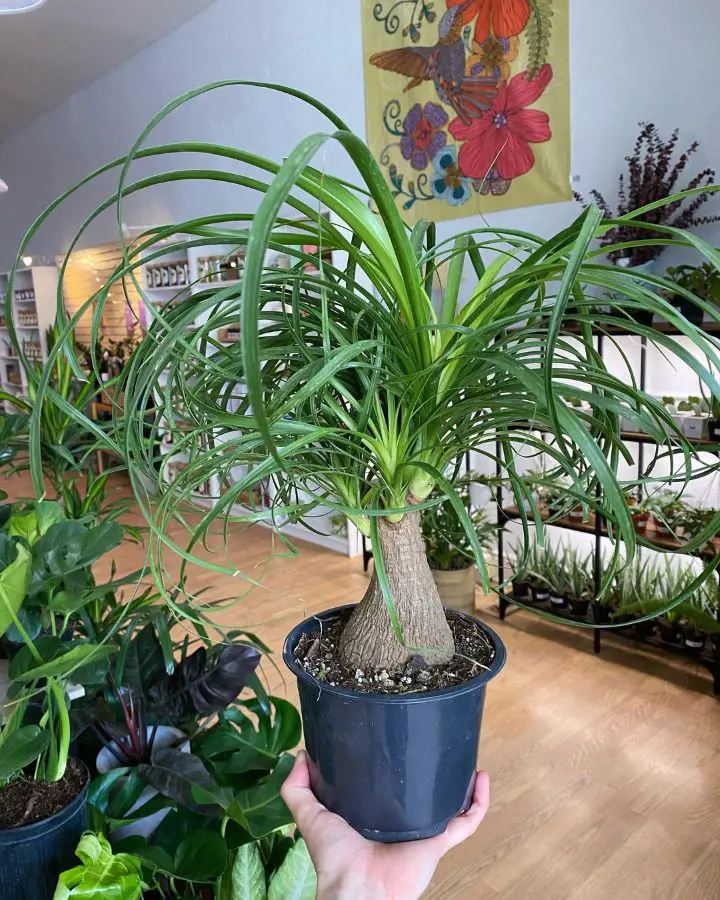
Ponytail palms are popular indoor plants because of their striking appearance, low maintenance requirements, and ability to tolerate neglect.
With proper care, ponytail palms can live for several decades and are known to be relatively resilient to pests and diseases.
Light
Ponytail palms thrive in bright, indirect light. Place them near a window where they can receive plenty of sunlight throughout the day. They can tolerate some direct sunlight, especially in the morning, but be cautious of intense afternoon sun, particularly in hotter climates.
If your indoor space lacks sufficient natural light, you can supplement it with artificial grow lights, especially during the darker months of the year.
Soil
Use a well-draining soil mix specifically designed for cacti and succulents. This type of soil prevents water from pooling around the roots, reducing the risk of root rot.
You can create a suitable soil mix by combining potting soil with sand, perlite, or pumice to improve drainage.
Temperature
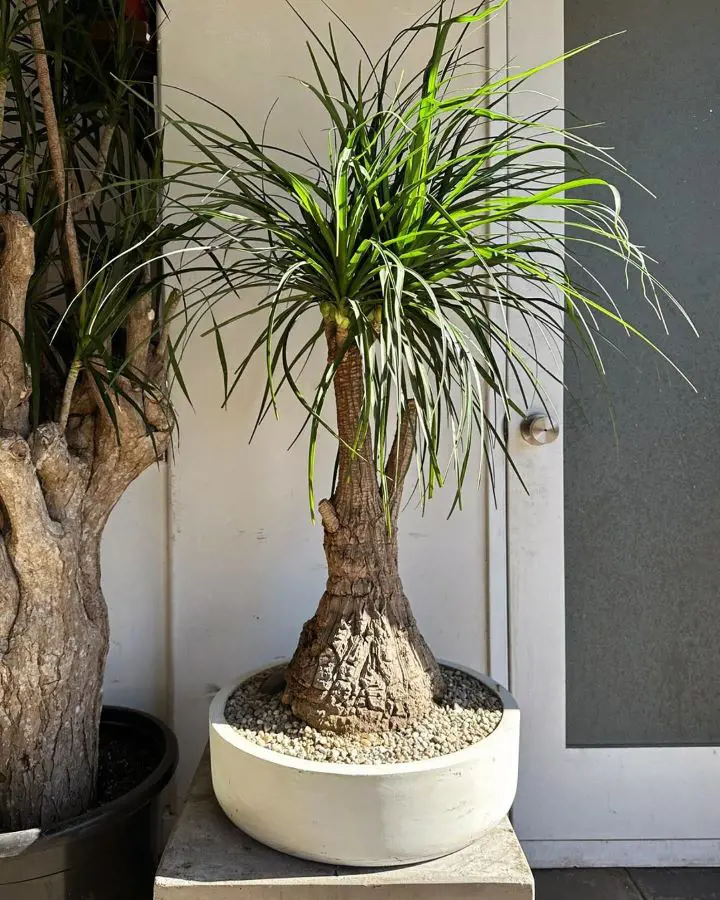
These plants prefer warm temperatures between 65 and 80°F (18 and 27°C). They can tolerate slightly cooler temperatures but should be protected from drafts and cold air. Avoid placing them near heaters, air conditioners, or drafty windows or doors.
Humidity
The Ponytail Palm is adapted to arid conditions and doesn't require high humidity levels. Average indoor humidity is typically sufficient for their growth.
Also, they can tolerate higher humidity levels without issue, so you don't need to worry about misting or humidifiers specifically for their sake.
Water
Ponytail palms are a type of succulent, meaning they store water in their swollen trunks and can tolerate periods of drought. It's crucial not to overwater them, as this can lead to root rot. Water thoroughly, allowing the soil to become almost completely dry between waterings. Stick your finger into the soil about an inch deep; if it feels dry, it's time to water.
You'll likely water your ponytail palm every 2-4 weeks, depending on factors like temperature, humidity, and light levels. During the winter months or periods of dormancy, reduce watering frequency to prevent waterlogged soil.
Fertilizer
Feed your ponytail palm with a balanced liquid fertilizer diluted to half-strength during the growing season (spring and summer). A general-purpose houseplant fertilizer works well. Avoid fertilizing during the winter months or periods of dormancy when the plant is not actively growing.
Cleaning
Cleaning a ponytail palm is relatively simple and mainly involves removing dust and debris from the foliage to keep the plant looking fresh and healthy. Aim to clean the plant every 1-2 months or as needed, depending on how quickly dust accumulates in your home.
Potting and Repotting
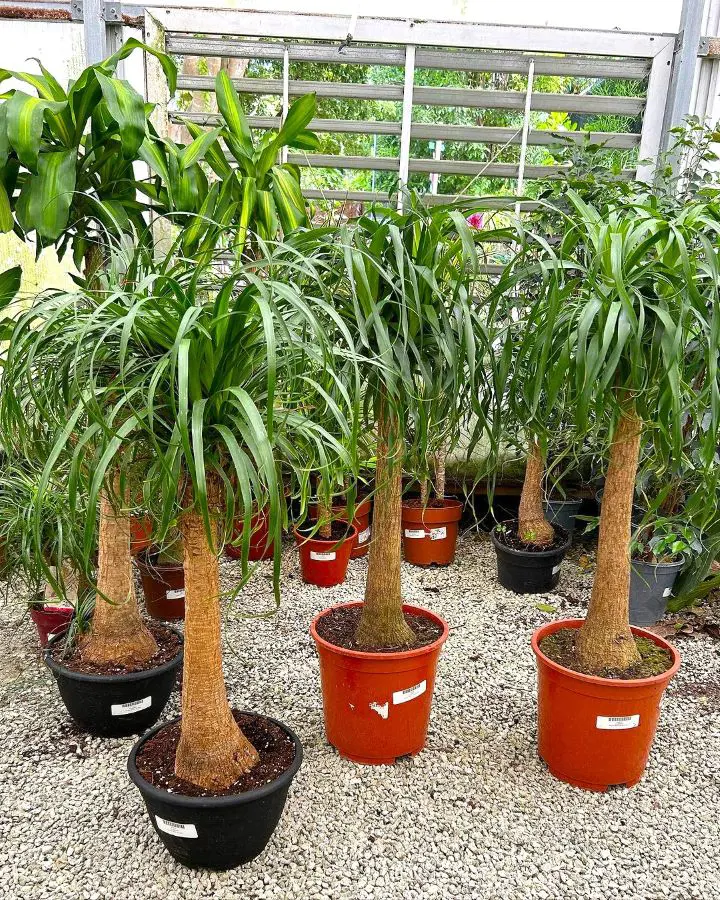
Care of ponytail palm requires them to be potted and repotted to ensure the plant's health and well-being. Select a pot that is only slightly larger than the plant's current pot. Ponytail palms have relatively small root systems and don't require a lot of room. Ensure the pot has drainage holes at the bottom to prevent water from pooling around the roots.
Use a well-draining soil mix designed for cacti and succulents. You can create your mix by combining potting soil with sand, perlite, or pumice to improve drainage.
Ponytail palms generally only need to be repotted every 2–3 years, or when the roots have outgrown the current pot. Carefully remove the plant from its current pot and inspect the roots. If they are tightly packed and circling the pot, it's time to repot.
Select a new pot that is only slightly larger than the current one to prevent overpotting. Follow the same steps as potting a new plant, ensuring proper drainage and soil mix.
After repotting, water the plant thoroughly and place it back in its preferred location with bright, indirect light. Avoid fertilizing for a few weeks to allow the plant to adjust to its new environment.
Propagating Ponytail Palm
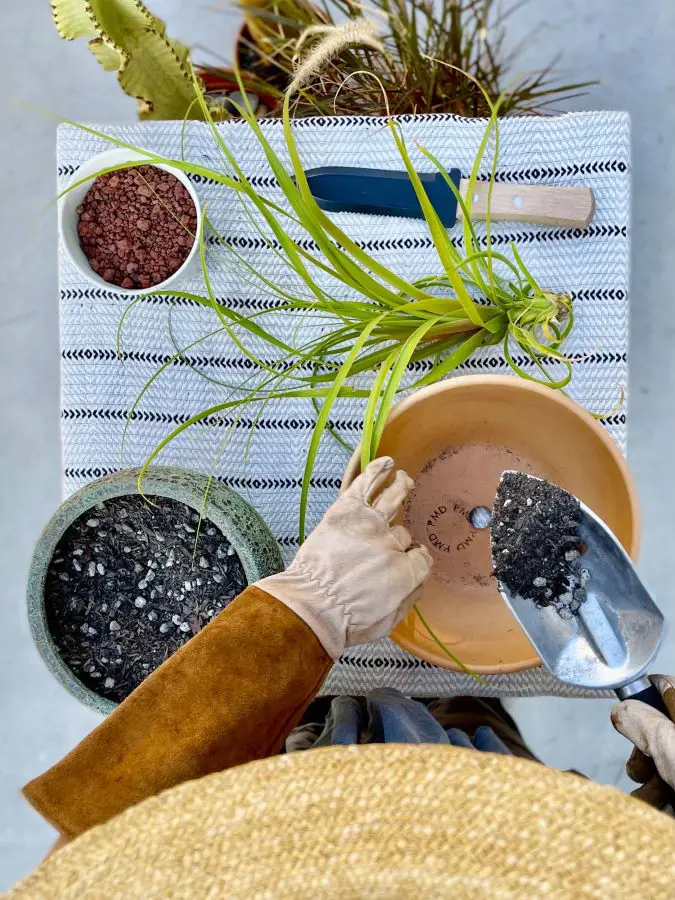
Indoor ponytail palm can be propagated best through offshoots or pups that develop at the base of the parent plant. Spring and early summer are the best times to propagate these tall indoor plants when they are entering their active growing season. During this time, the plant is better equipped to recover from the stress of propagation and establish new roots. Here is how to propagate through offshoots:
- Look for healthy offshoots at the base of the parent plant.
- Carefully separate the offshoot from the parent plant, ensuring it has some roots.
- Let the cut end of the offshoot dry and callus for a few days.
- Select a small pot with drainage holes.
- Plant the offshoot in well-draining soil, covering the roots and base.
- Water the offshoot lightly, allowing the soil to dry slightly between waterings.
- Place the pot in bright, indirect light.
- Watch for new growth and continue regular watering until the offshoot establishes itself.
Pruning a Ponytail Palm
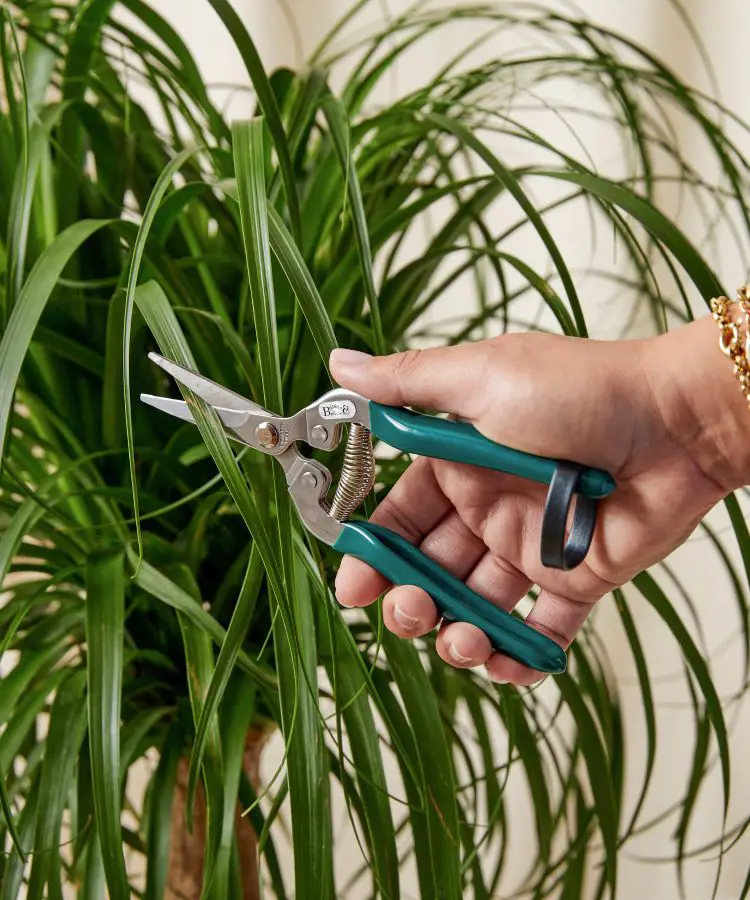
Care for Ponytail Palm should be done by pruning minimally and mainly focusing on removing dead or damaged leaves. This process can be done as needed throughout the year.
- Regularly check your ponytail palm for any dead, yellowing, or damaged leaves. These can be removed to maintain the plant's appearance and health.
- Use clean, sharp scissors or pruning shears for pruning. This helps prevent the spread of disease and ensures a clean cut.
- Carefully snip off dead or damaged leaves at the base where they meet the trunk. Make sure to cut as close to the trunk as possible without damaging it.
- If desired, you can trim the tips of healthy leaves to maintain a tidy appearance. However, this is not necessary for the plant's health and should be done sparingly to avoid stress.
Pest Control

Palm ponytail plant, despite their resilience, can still be susceptible to a few pests. The most common pests affecting them are mealybugs, scales, and spider mites. Meanwhile, common diseases include root rot, leaf spots, and bacterial leaf streaks.
Mealybugs
Mealybugs feed on the sap of the plant, weakening it and causing the leaves to yellow, wilt, or develop stippling. Severe infestations can lead to leaf drop and an overall decline in plant health.
To improve the condition of a ponytail palm affected by mealybugs, treat the plant with insecticidal soap or neem oil, following the manufacturer's instructions.
Root Rot
Root rot occurs when the roots of the ponytail palm are consistently overwatered or subjected to poorly draining soil. To prevent root rotting, improve drainage, repot the plant in a well-draining soil mix, and ensure that the pot has proper drainage holes.
Leaf Spots
Leaf spot diseases, caused by fungi or bacteria, manifest as dark, water-soaked spots on the leaves of the ponytail palm. Improve air circulation around the plant by pruning away any overcrowded foliage.
There are several organic and inorganic methods for controlling pests and diseases, one of which is neem oil.
Winter Care
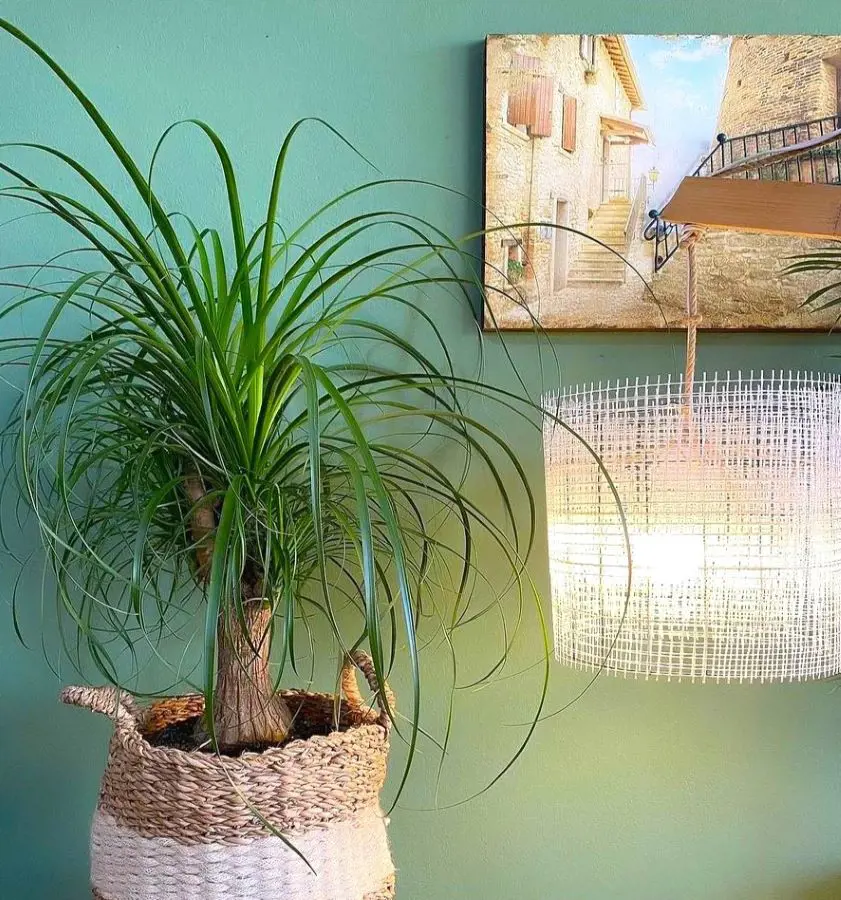
Ponytail Palm tree plant are native to arid regions of Mexico and are adapted to warm, dry climates. While they can tolerate cooler temperatures, they are not frost-tolerant and can be damaged or killed by freezing temperatures.
In regions where winter temperatures drop below 50°F (10°C), it's essential to protect these indoor trees from cold drafts and frost. Ideally, they should be kept indoors during the winter months or moved to a sheltered location if grown outdoors in containers.
If your Ponytail Palm must remain outdoors during the winter, consider providing additional protection during cold snaps. This may include covering the plant with frost cloth or bringing it indoors temporarily until the cold weather passes.
Additional Tips for Ponytail Palm Care
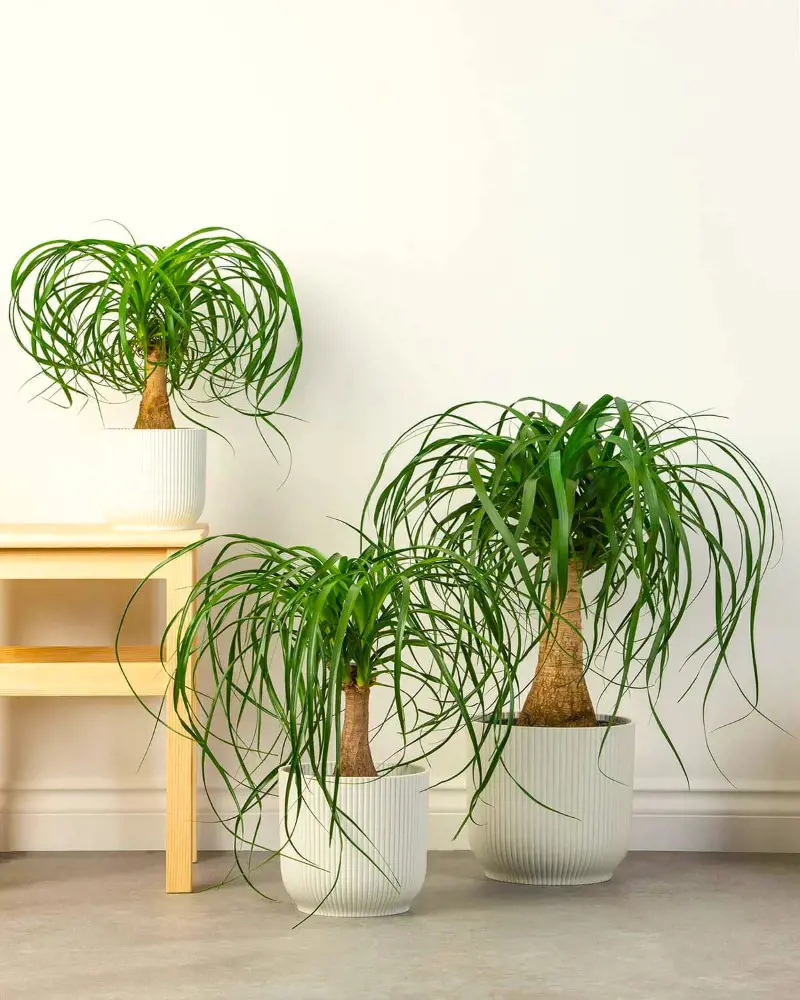
While the core care requirements of light, soil, and water are crucial, these additional tips can elevate your ponytail palm's well-being and appearance:
Rotation
Ponytail palms naturally lean towards the light source. Regular rotation (every 2-4 weeks) ensures even growth and prevents them from becoming lopsided. Gently turn the pot a quarter turn each time you rotate. This exposes all sides of the plant to equal light distribution.
Air Circulation
Proper air circulation helps prevent fungal diseases and promotes healthy leaf development. Avoid placing your palm directly next to walls, furniture, or stagnant corners. Provide gentle air movement with a fan placed at a distance, ensuring it doesn't blow directly on the leaves.
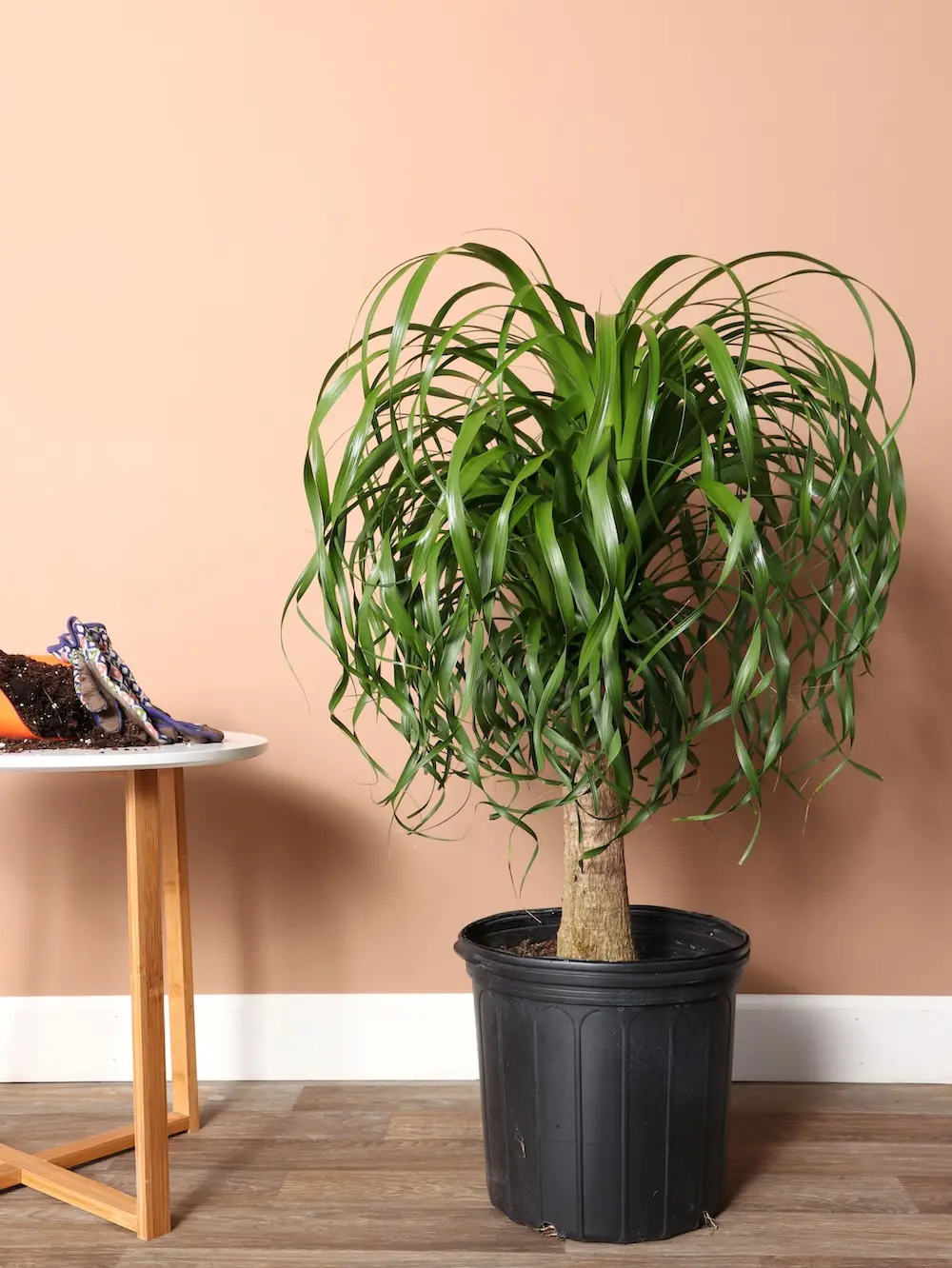
Outdoor Adventures (Summer Only)
A change of scenery and fresh air can boost your palm's health during the growing season. Gradually acclimate your palm to outdoor conditions by taking it outside for short periods in shaded areas first. Increase the duration and sun exposure gradually over a week or two. Choose a location with filtered sunlight and protection from strong winds or rain. Bring it back indoors before the temperature drops significantly.
Acclimatization
Whenever introducing your ponytail palm to a new environment, whether it's outdoors for the season or in a different spot indoors, remember to acclimate it gradually. Sudden changes in light, temperature, or humidity can stress the plant. Make gradual adjustments over days or weeks to allow it to adapt smoothly. Acclimatization helps reduce transplant shock and stress, allowing the plant to establish roots and thrive in its new surroundings.
Things to Avoid While Caring for Ponytail Palm
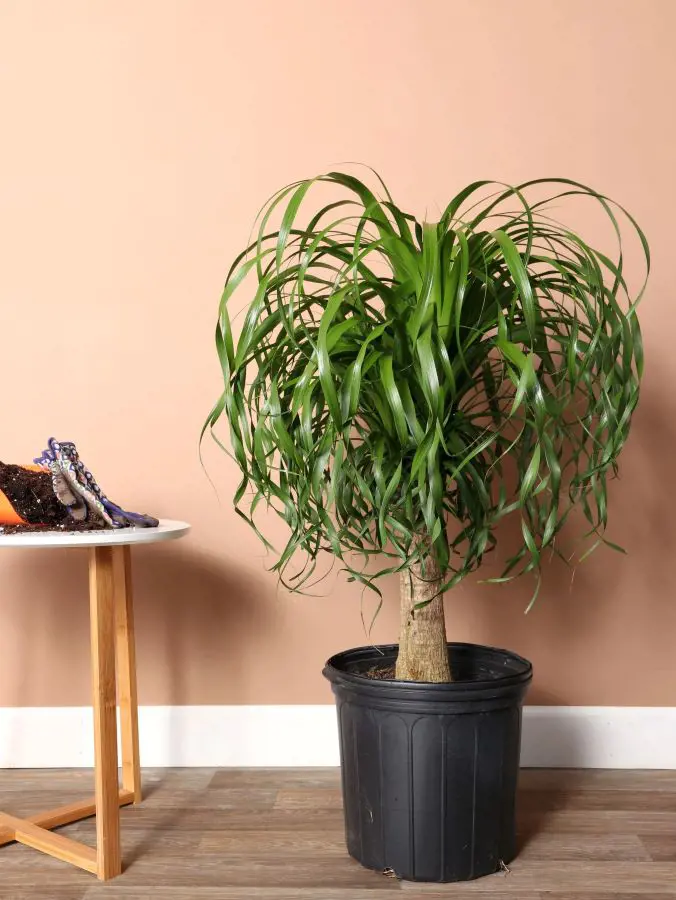
While ponytail palms are relatively low-maintenance, there are some key things to avoid to keep them happy and healthy. Here are some crucial points to remember:
- Sudden changes: Introduce them gradually to new environments, like outdoors in the summer.
- Overwatering: This is the top culprit for problems like root rot. Always let the soil dry completely between waterings.
- Direct, harsh sunlight: While they enjoy bright light, intense midday sun can scorch the leaves. Opt for filtered or indirect light.
- Cold drafts and temperatures: Avoid drafty windows, air conditioners, and areas with fluctuating temperatures below 60°F.
- Soggy soil: Ensure your pot has drainage holes and use a well-draining potting mix to prevent waterlogging.
- Overfertilizing: Stick to a diluted fertilizer during the growing season and avoid fertilizing in the winter. Too much fertilizer can damage the roots.
- Frequent repotting: Repot only when necessary, every 2-3 years, or when rootbound. Oversized pots can lead to overwatering.
- Harsh chemicals: Avoid using harsh cleaning solutions on the leaves, as they can damage the delicate foliage.
Recent posts
Plant Care
Plant Care
How To Grow and Care For Peace Lily Plant
The Peace Lily is an indoor plant that is most valued for its beautiful and shiny green leaves as well as the white blooms. Hard and tolerant, it’s naturally a low-maintenance addition to your plant collection. If you are confused, let us tell ...
Plant Care
Pothos Plant Care And Growing Guide
Adding a Pothos plant (Devil’s Ivy) to your home benefits the environment and aesthetic of your personal space. It's easy to maintain and is loved for it's ability to enhance indoor air quality by removing toxins like formaldehyde, benzene, and...
Plant Care
Snake Plant Care and Growing Guide
Snake plants require low maintenance, and low light and are almost impossible to kill, making them a perfect plant for beginners and seasoned gardeners. In this guide, we will explore essential care tips and optimal growing conditions for snake plant...
Plant Care
Orchid Plants Care: 11 Tips And Tricks You Should Follow
If you love gorgeous orchids but are worried they're too high-maintenance, don't worry. This guide is like a cheat sheet for orchid newbies. Forget fancy words and confusing schedules—we're talking about 11 easy tips to keep your orchid happy a...
Plant Care
How To Plant, Grow and Care Majesty Palm
The majestic palm, scientifically known as Ravenea rivularis, makes for a stunning indoor tree with its lush and grand fronds. Originating from Madagascar's river banks, this resilient houseplant is cherished not only for its beauty but also for its ...
Plant Care
How To Grow And Care For A Hosta Plant
Hosta plants are widespread perennials, often grown for their beautiful and diverse foliage. They are extremely easy to care for and can thrive in various conditions, particularly shade or semi-shade. These hardy plants can last for many years and re...
